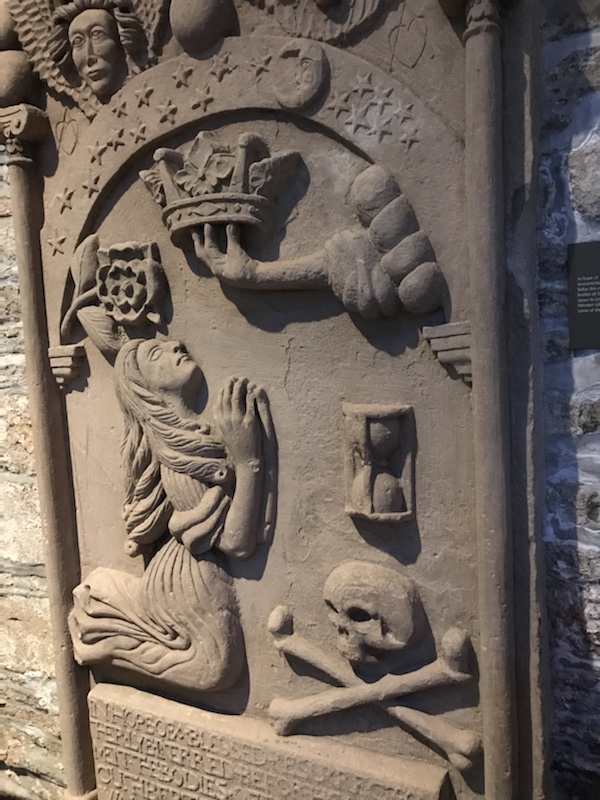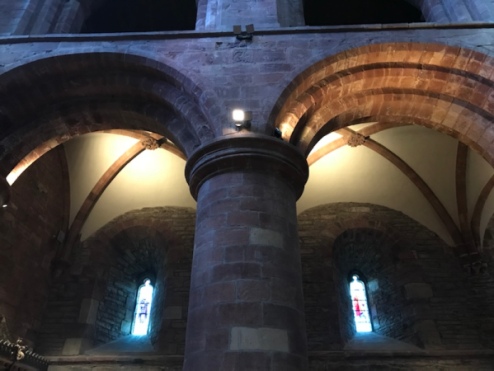The traditional picture of the Vikings – looting, marauding, raping invaders – may not be entirely true of their time on Orkney, though they did rule this gentle archipelago with an iron fist for five hundred years… (1300 words, a ten-minute read)

(Above: the glory of St Magnus (Viking) Cathedral, Kirkwall)
History can be complex. Patterns of events that fit in one situation may not, even from the same peoples, dovetail into another. To understand why Orkney’s history of these times is likely to have differed from what might be expected, we need to put ourselves in the minds of the Vikings and examine what Orkney represented to them.

(Above: one of the ancient religious stones)
The sophisticated stone-age race that built the Ness of Brodgar temple-complex and neighbouring stone circles had long gone from Orkney. But the Norsemen did not immediately fill the gap.
No-one knows if anyone did, though farming continued – but without the intense spiritual concentration of former times. During the late Iron Age and for at least 400 years, the dominant cultural force on Orkney was Pictish. It’s likely that they came north, expanding their successful base centred on Inverness. They ruled Orkney for almost as long as the Vikings did, after them. Orkney had its own Pictish Kings, but, though powerfully autonomous in the islands, they were subservient to Inverness in wider Pictish affairs.
In many ways, our own journey over this extended weekend had mirrored that of the Picts. But we had already covered their achievements and culture further south, and they are documented in the earlier blogs (see below). The much more ancient wonders of Orkney had been our focus here. But, now, the story of the Picts had come into view, again, if only in the way they were subsumed into the Viking future, here on Orkney. There seems to have been little warfare, so perhaps they co-existed for a long time, Eventually, the Viking tribes emerged as the stronger cultural force, in line with the expansion of the whole Norse culture, driven by the ambitious Kings of Norway.
In many ways, Orkney was already theirs…

(Above: the pulpit at St Magnus Cathedral)
The Vikings were, essentially, seafarers. They were brave and fearless warriors and mariners of great skill. From their native bases in Scandinavia, they expanded across the world, following oceans and river systems deep into Europe and along the northern and western edges of Britain. Whenever they made these western journeys, they had to sail past Orkney. Its gentle hills and safe harbours were a haven to them. It was a natural stopping point on their outward and return journeys; and there are records (and sagas) of Norwegian royalty being entertained on Orkney, by their Earls – a measure of how important this place was in Viking times.
I hadn’t realised that the Vikings built Christian cathedrals, or that they had Earls, like the English. But both were here in Orkney during the height of their power. It’s confusing when you first look at St Magnus Cathedral in Kirkwall, the capital of Orkney, and the place which became their power base in the later years of their reign. The location of the Cathedral is co-existent with the Earl’s Palace and the Palace of the Bishops across the street. So your first reaction is why there was so much ‘British hierarchy’ so far north?

(Above: the ruin of the Earls’ Palace, opposite the Cathedral)
But it’s not. Both the Cathedral and the two palaces are from the period when the Vikings ruled Orkney, administering it under the control of their own, powerful Earls – often two at a time, which was the gravitational force that created St Magnus Cathedral.

(St Magnus Cathedral: the main East-West axis)
The story of how St Magnus Cathedral came to be, and came to be here, is one of internecine warfare and a touch of Viking opportunism.
In 1103 the Viking cousins Magnus Erlendson and Haakon Paulson succeeded to the Earldom of Orkney. At first all went well, but, by 1117, major disputes had arisen. It was agreed that these would be resolved by a meeting on the island of Egilsay on 16th April of that year. Rules of engagement were drawn up, the core of which was that each Earl would take only two ships.
Haakon arrived with six, overwhelming the honest Magnus, who, though threatened with his life, refused to give up his Earldom. Haakon ordered Magnus’ own cook, Lifolf, to kill his master with a meat cleaver blow to his head.
A cenotaph now stands on the spot where this happened. Magnus was buried at Birsay, in the north of the ‘mainland’. Birsay was the Viking Earl’s base at the time, from which they could watch the northern waters. Magnus’ fame and the horror and dishonour of his death meant prayers were said for his soul and pilgrims began to visit his grave. Miraculous cures were reported and soon the place assumed legendary status.
Earl Haakon, now politically secure, became worried by this notoriety and made a pilgrimage to Rome to stabilise his position with the Christian church. He seems to have been successful. He was succeeded as Earl by his son, Paul… and now the tale gets interesting…

(Above: Rognvald Kolson holding a model of the original Cathedral dedicated to his uncle)
Paul was deposed in 1135 by the murdered Magnus’ nephew Rognwald Kolson, who declared his uncle a saint and vowed to raise money from the farmers of Orkney to build a vast cathedral dedicated to St Magnus. Durham masons – among the most skilled in Britain – were drafted in to supervise the design and construction. The new generation of Christian Bishops were a powerful force, and Rognwald Kolson, St Magnus’ nephew, made sure that the three buildings sat side by side. We can assume his political skills were as astute as his military prowess…

The cathedral was consecrated in 1150, when St Magnus’ remains were transferred from Birsay to a shrine in the east of the new church. The building was lengthened and extended in the next two centuries, and was completed to its present form in the 14th century.
Over the years that followed, it fell into disrepair – the Viking rule is not remembered here with fondness. But, in the past twenty years, extensive repair work has been carried out, which has made the St Magnus Cathedral more a more positive part of Orkney’s emotional future. It’s a very beautiful building, and a thriving centre of Kirkwall, which is a feature-rich place to visit.
Our time on Orkney was nearly over. We had one more day to explore, and we had chosen to leave the ‘Mainland’ for the first time and visit one of the neighbouring islands – Rousay. There, we knew, was an extensive defensive structure from the Iron Age. But first, we had to face a tense time on the ferry crossing!
The humorous and terrifying short ferry journey has already been written up as part of the parallel ‘incidentals’ blogs. The link is here.
The story of our final full day on Orkney and its visit to Rousay will be published on Thursday’s blog.
To be continued.
If you would like to be notified of future Silent Eye weekends, drop us a line to rivingtide@gmail.com, saying what your areas of interest are.
Other parts in this series:
Part One, Part Two, Part Three, Part Four, Part Five, Part Six, Part Seven, this is Part 8.
The preceding Pictish Trail weekend blog posts:
Part One, Part Two, Part Three, Part Four, Part Five, Part Six, Part Seven, Part Eight, Part Nine
©Stephen Tanham, 2020.
Stephen Tanham is a Director of the Silent Eye – a journey through the forest of personality to the sunrise of Being.

Thank you, Sue x